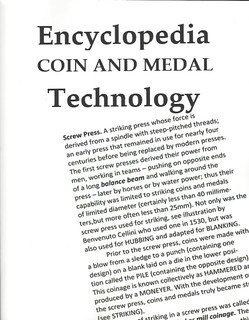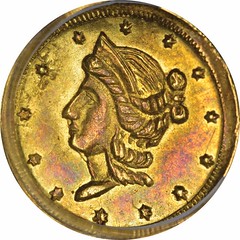
PREV ARTICLE
NEXT ARTICLE
FULL ISSUE
PREV FULL ISSUE
PRIVATE GOLD COINS OF CALIFORNIABob Leonard submitted this overview of the private gold coins of California. Thanks! -Editor
First, there are the pieces struck from 1849 through 1855 in San Francisco, in denominations from $5 to $50, which were represented as having the full gold value equivalent. (Some didn’t.) They are described on pp. 390-402 of the 2017 Red Book, chapters 4 through 7 of Dr. Donald H. Kagin’s Private Gold Coins and Patterns of the United States (except pp. 119-122), and cataloged in Edgar H. Adams Official Premium List of United States Private and Territorial Gold Coins (1909), pp. 44-60, and his Private Gold Coinage of California, 1849-55, Its History and Its Issues (1913). All these were expected to pass current at face value; all are very expensive today. Second, the small (“fractional”) pieces in denominations of ¼ dollar to 1 dollar, issued beginning in 1852. Besides the lack of larger coins that led to the formation of private mints, there was also an extreme shortage of small change in California in the early 1850s. In the Annals of San Francisco, concerning the year 1851, the authors wrote, “Specimens of nearly all the coinage of the civilized world were in constant circulation. Approximate values were bestowed upon the pieces, and if anything like the mark, they readily passed current. The English shilling, the American quarter-dollar, the French franc, the Mexican double-real were all of the same value; so likewise were the English crown, the French five-franc piece, and the American or Mexican dollar. It did not matter although some were twenty-five per cent. more worth than others. Four single francs were quite as good as the English five-shilling piece. The smaller silver coins of whatever denomination and of every country were all alike bits, and passed for the same value.” With citizens indifferent as to the value of small change, jewelers stepped in to make their own quarters, halves, and dollars—though also overvalued. Further evidence is found in an article in The Jewelers’ Circular-Weekly, Feb. 5, 1919: “There was no such thing in those days [1849-early 1850s] as a one-price system. The jeweler sized up his customer and charged accordingly. The price was paid in gold dust. Scales stood on the counter and the jeweler weighed out enough of the dust to cover the cost of the sale….To facilitate trading where small amounts were involved, 25 cent, 50 cent and $1 gold coins were in current use, it being rather difficult to weigh out such small quantities of dust.” Too small for a pocket, these coins were carried in gold dust pouches. (See Breen-Gillio, California Pioneer Fractional Gold, second edition, for extended quotations from these and other sources. These small coins were not noticed by Adams.) Never carrying their full value, weights of these issues were reduced by 1853, with little effect on circulation. But the coin shortage eased when the new San Francisco mint began coining quarters and halves in 1855 and dimes in 1856; 1856 is the last common date before 1859, by which time they were purely souvenirs or charms. In the first edition of California Pioneer Fractional Gold, Walter Breen defined Period One, 1852-1856, as “Historic Gold Rush Small Change.” (Since a few rare pieces are dated 1857, Period One was extended to 1857 in the second edition.) In 1859 (one piece is dated 1858), small California gold reappeared; Breen labeled these Suppressed Jewelers’ Issues, because they were suppressed by the Secret Service in 1883 (last date is 1882, though; some were backdated by then), defining Period Two as 1859-1882 (1858-1882 in second edition). As time went by, these pieces became much lighter and almost paper thin. In the 1893 edition of Scott Stamp & Coin Co.’s Standard Coin Catalogue. Silver and Gold., p. 8, the cataloger writes, “1875 is about the closing year of ¼, ½, and $1 pieces which possessed weight and fineness approximate to legal issues and were current; thereafter followed base representations, charms, bangles, etc., which we do not chronicle or traffic in.” In John Lupia’s biography of Ernest Haquette (E-Sylum Vol. 20 No. 7), he notes that Haquette paid $1.00 each for California “gold Quarters and Half Dollars dated prior to 1870…when Fine. No demand for charms.” Thus, Scott carried Period One as late as 1875, while Haquette cut it off at 1870; Breen stopped at 1856, with which date most specialists agree. However, the entire series is now considered “genuine,” and is so listed in the Red Book, pp. 407-408. Breen included a Period Three, outright modern counterfeits. Some of these were actually restruck in recent years from original (counterfeit) dies. ALL BG numbers beginning with 1300 are counterfeits, though (as with other counterfeits), there are specialists who collect them. Finally, we have the so-called “tokens,” condemned in the Red Book and by Bugeja. These began in 1872, following the 1871 arrest of jewelers (in Leavenworth, Kansas!) who were making “California gold pieces.” Round dollars were discontinued that year, and one maker introduced the head of Washington to avoid too much similarity to U.S. coins. No enforcement appeared in California until 1876, though, but this led to the abandonment of octagonal dollars also, backdating, and the introduction of denominationless pieces reading ¼ CAL GOLD, etc. instead of ¼ DOLLAR. (See California Pioneer Fractional Gold, second edition, p. 39, for a fuller explanation and illustrations.) Modern “tokens” do not even contain gold. The best reference for them is Mike Locke’s website, http://www.calgoldcoin.com/ . To read the earlier E-Sylum articles, see:

LAST CALLIf you want a copy of this incredible book order now at the discounted price of $50. Price goes up to original price of $100 on April 15 if any copies are still available.Encyclopedia of Coin and Medal Technology 1,854 entries on every aspect of how coins and medals are made, cataloged and collected., Sample entries in recent E-Sylum issues as Vocabulary Words. Do not miss this opportunity! 678 pages, card cover. . . . .$50 Monograms of American Coin and Medal Artists. Identifies over 450 initials and monograms found on American coins and medals. 147 pages, card cover. . .. . . $45 Who’s Who Among American Medallists. Biographies of 4,137 artists of American coins and medals, with some as long as 4 pages. With article of American Art Styles, bibliography 386 pages, Hard cover. . … $65 Dick Johnson 139 Thompson Drive Torrington, CT 06790 Wayne Homren, Editor The Numismatic Bibliomania Society is a non-profit organization promoting numismatic literature. See our web site at coinbooks.org. To submit items for publication in The E-Sylum, write to the Editor at this address: whomren@gmail.com To subscribe go to: https://my.binhost.com/lists/listinfo/esylum All Rights Reserved. NBS Home Page Contact the NBS webmaster 
|
